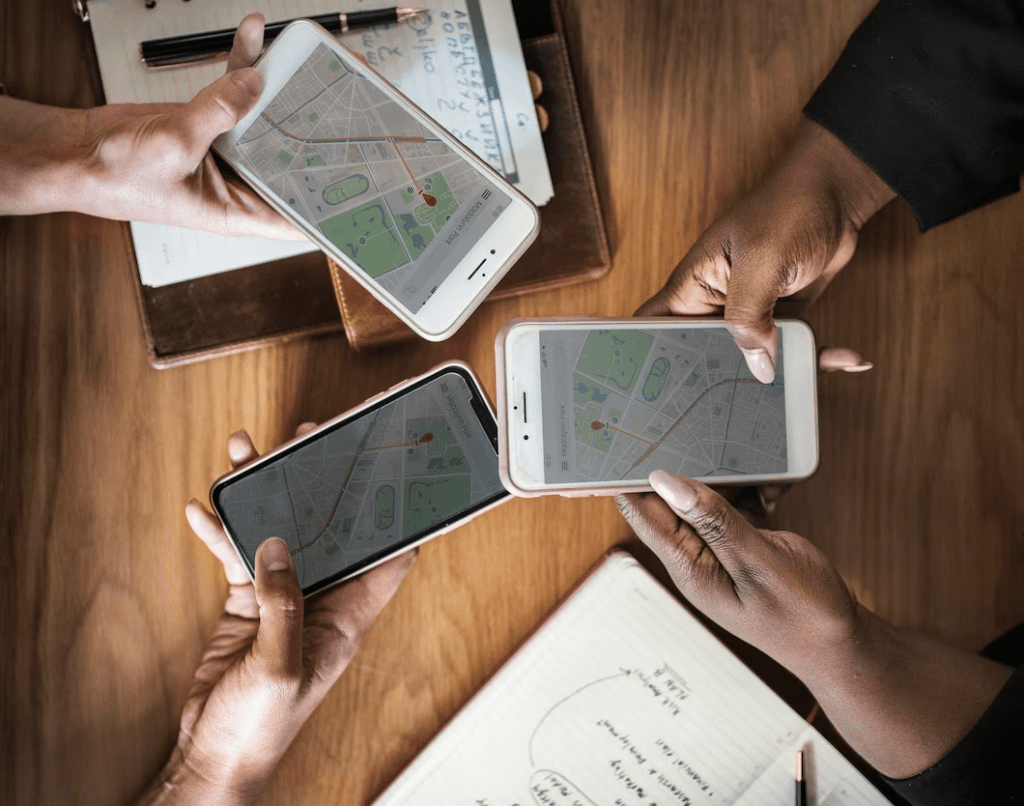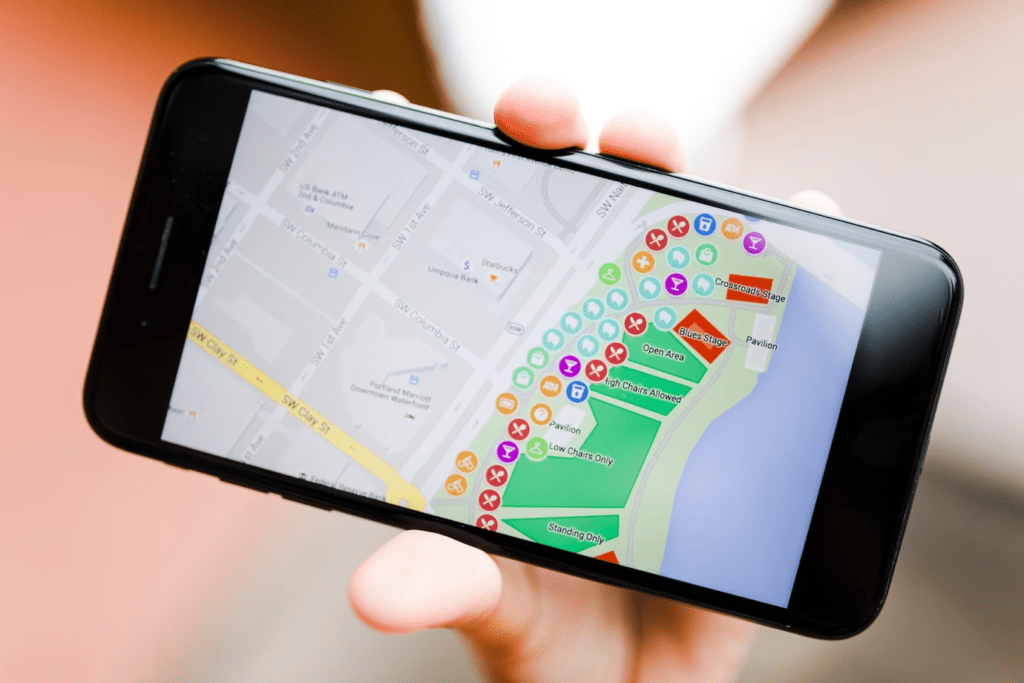Within the swiftly evolving discipline of land surveying, an era has revolutionized the way experts gather, examine, and control spatial information. Mobile packages have emerged as helpful tools for land surveyors, permitting them to increase productivity, accuracy, and efficiency in their work. This text explores the 15 best land surveying apps to be had for Android and iOS in 2025, highlighting their features, functionalities, and blessings.
Benefits of using land surveying apps
One goal of developing land surveying apps is to make field data collection more efficient and paperless. The land survey method now uses a smartphone app to capture data rather than paper sheets, which is then securely saved in the cloud. Businesses can reap multiple benefits from digitizing data:
- Verify Precision: The use of an app during land surveys guarantees the real-time recording of data obtained on site, allowing for an especially precise retrieval of details.
- Try standardisation: To make sure all the necessary information is gathered correctly, businesses benefit as well from having standard templates and mandatory fields on mobile applications.
- Maximize Productivity: To help employees reduce their effort and time, smartphone applications are meant to instantly generate a prepared report following the site survey, rather than requiring them to spend time laboriously creating the report.
- Activities on a Large Scale: Scaling procedures and ensuring consistency across numerous sites and teams is made easier with software as well as mobile apps for complicated enterprises with big operational needs.
- Stay Out of Danger: Digital documents that have automatic backing up in the cloud will guarantee that paperwork is always accessible when needed, unlike paper sheets which can be accidentally destroyed or lost.
Top 15 Best GPS Land Survey Apps For iPhone & Android 2026
Trimble Mobile Manager
Trimble Mobile Manager is a comprehensive land surveying app that provides precise GPS positioning, data collection, and stakeout capabilities. It offers real-time data syncing, supports various file formats, and allows seamless integration with Trimble receivers and other surveying equipment.
AutoCAD Mobile
AutoCAD Mobile, developed by Autodesk, offers powerful drafting and design tools on mobile devices. Land surveyors can easily view, edit, and annotate CAD drawings in the field, ensuring accurate measurements and efficient data management.
ArcGIS Collector
ArcGIS Collector, part of the Esri suite, is a versatile app that enables land surveyors to collect and update field data with ease. It provides advanced mapping capabilities, supports offline data collection, and offers integration with ArcGIS Online for efficient collaboration and data sharing.
Survey123 for ArcGIS
Survey123 for ArcGIS simplifies the data collection process for land surveyors. With its intuitive interface and customizable forms, professionals can easily capture field observations, perform inspections, and collect survey data using their mobile devices.
Mappt
Mappt is a user-friendly mobile GIS and data collection app that offers robust features for land surveyors. It provides offline mapping, data visualization, and advanced data management capabilities, making it an ideal tool for conducting surveys in remote areas.
iCMTGIS PRO
iCMTGIS PRO is a comprehensive land surveying app that combines GPS/GNSS data collection, stakeout, and mapping functionalities. It supports custom data forms, offers real-time positioning, and allows integration with external GNSS receivers for enhanced accuracy.
GeoJot+
GeoJot+ is a powerful photo-based data collection app designed for land surveyors. It enables professionals to capture geotagged photos, record field notes, and collect survey data with ease. The app supports customizable forms and offers seamless integration with popular GIS software.
LandGlide
LandGlide is an app that provides access to detailed parcel information and property boundaries. Land surveyors can easily view land ownership data, property lines, and tax information, helping them make informed decisions in the field.
GeoMeasure
GeoMeasure is a versatile app that offers a range of measurement tools for land surveyors. It allows users to measure distances, areas, and angles using GPS or manual input. The app supports both metric and imperial units, ensuring compatibility with various surveying standards.
GPS Fields Area Measure
GPS Fields Area Measure is a handy app for measuring land areas and distances. It provides accurate measurements using GPS technology and offers advanced features like perimeter calculation and data export for further analysis.
Land Calculator
Land Calculator is a useful app for land surveyors, providing tools for calculating land parcel area, perimeter, and coordinates. It supports multiple coordinate systems and allows users to save and share their calculations effortlessly.

Planimeter GPS Area Measure
Planimeter GPS Area Measure allows land surveyors to measure land areas and distances on maps. With its intuitive interface and accurate measurements, professionals can quickly assess land boundaries and calculate acreage or square footage.
GeoMeasurements by Google
GeoMeasurements is a feature within Google Maps that allows land surveyors to measure distances and areas directly on the map. While not as feature-rich as other dedicated surveying apps, it provides a quick and convenient solution for basic measurements.
GPS Essentials
GPS Essentials is a comprehensive GPS app that provides land surveyors with essential tools for navigation and data collection. It offers various measurement features, compass functionality, and customizable data screens to cater to individual needs.
Locus Map Pro
Locus Map Pro is a versatile GPS navigation and mapping app that offers advanced features for land surveyors. It provides precise positioning, track recording, waypoint management, and comprehensive map customization options.
Cell apps have considerably transformed the manner and surveyors’ paintings, allowing them to streamline data collection, improve accuracy, and enhance overall productivity. The 15 apps listed in this newsletter represent the first-class alternatives available for Android and iOS customers in 2025, supplying a huge range of capabilities and functionalities tailored to the wishes of land surveying experts. By harnessing the electricity of these apps, surveyors can raise their performance and effectiveness in the subject, in the end contributing to the advancement of the land surveying enterprise.
What Is The Most Accurate Surveying Tool?
Correct measurements are the cornerstone of land surveying, ensuring unique mapping, boundary determination, and production planning. Through the years, surveying gear has developed, incorporating superior technology to enhance accuracy and performance. In this text, we are able to explore numerous surveying gear and decide which one may be the most correct alternative.
Total Station:
Total stations are widely used in land surveying due to their high accuracy and versatility. These instruments combine electronic theodolites, electronic distance measurement (EDM) systems, and data collectors to measure angles, distances, and elevations. Total stations offer millimeter-level accuracy, making them suitable for detailed surveying tasks.
Global Navigation Satellite System (GNSS):
GNSS receivers, along with GPS (International Positioning System) and GNSS (Global Navigation Satellite System) gadgets, have revolutionized surveying. With the aid of receiving indicators from satellites, GNSS receivers determine unique positions on the planet’s surface. When combined with real-time kinematic (RTK) technology, GNSS receivers can achieve centimeter-level accuracy, particularly in open-sky environments.
Real-Time Kinematic (RTK) Systems:
RTK systems provide real-time corrections to GNSS receivers, improving their accuracy. RTK involves a base station that receives signals from GNSS satellites and a rover that receives corrections from the base station. These corrections compensate for errors caused by atmospheric conditions and other factors, resulting in highly accurate positioning, often within centimeters.
High-Definition Laser Scanning (HDS):
Excessive-definition laser scanning, also known as terrestrial laser scanning, utilizes laser beams to create precise, three-dimensional representations of objects and environments. HDS gadgets emit laser pulses and measure the time it takes for the pulses to go back, making an allowance for correct distance calculations. With millions of points captured per second, HDS provides highly accurate and detailed survey data.
Unmanned Aerial vehicles (UAVs) or Drones:
UAVs ready with photogrammetry sensors and high-resolution cameras have grown to be more and more popular in surveying applications. Drones seize aerial imagery processed using a photogrammetry software program to generate accurate 3-D models and maps.
While drone surveys can achieve impressive accuracy, it is important to note that external factors such as wind conditions and GPS signal quality can affect their performance.
Robotic Total Station:
Robotic total stations combine the functionalities of traditional total stations with automated features. These instruments can be remotely controlled, allowing surveyors to operate them from a distance. Robotic total stations offer high accuracy and are particularly useful in challenging or hazardous surveying environments.
High-Precision Digital Levels:
Digital levels are used to measure height differences or elevations accurately. High-precision digital levels employ advanced electronic sensors and digital readouts to provide accurate height measurements. These instruments are particularly useful in applications that require precise leveling, such as construction projects or topographic surveys.
When it comes to accuracy in surveying tools, multiple options offer high precision for different applications. Total stations, with their advanced technology and millimeter-level accuracy, remain one of the most widely used instruments in land surveying. However, the advent of GNSS technology, especially when combined with RTK systems, has revolutionized surveying accuracy, providing centimeter-level precision.
Additionally, HDS, UAVs, robotic total stations, and high-precision digital levels offer their unique advantages in specific surveying scenarios. In the long run, the choice of the maximum correct surveying tool relies upon the precise necessities, environmental conditions, and the level of accuracy required for a given task. Surveyors should carefully evaluate their wishes and pick the most appropriate device to ensure the maximum accuracy and reliability of their surveying endeavors.

Which app is better for iOS or Android for land surveying
Both Android and iOS structures provide various 86f68e4d402306ad3cd330d005134dac land surveying apps, and determining which one is higher relies upon individual wishes and alternatives. But, it’s really worth noting that a few apps might also have versions in functionality or overall performance between the two platforms. Here are some elements to take into account when deciding between iOS and Android for land surveying apps:
App Availability: Check the supply of the particular land surveying apps you’re interested in on each platform. While most popular apps are to be had for both iOS and Android, there can be mild differences in capabilities or updates between the 2 versions.
device Compatibility: Remember the compatibility of the app with the devices you may be using. Some land surveying apps may be optimized for specific devices or working systems, which can have an impact on your desire for a platform.
Consumer interface and user enjoyment: Compare the person interface and user enjoyment of the app on both iOS and Android platforms. Some customers might also opt for the layout and functionality of 1 platform over the other, so it’s important to try out demos or examine personal critiques to gauge the general person’s experience.
Integration and Ecosystem: Consider the ecosystem or integration possibilities that each platform offers. For example, if you are already using different apps or equipment that are particular to either iOS or Android, it can be more handy to choose a land surveying app that aligns with your current environment.
In the end, the “higher” platform for land surveying apps comes down to private desire, tool compatibility, and the unique capabilities and skills that can be most important to your surveying wishes. It’s endorsed to investigate and try out demos or trial versions of the apps you’re considering to make a knowledgeable decision based on your needs.
Pros and Cons of Land Surveying Apps for Android & iOS: A Comprehensive Analysis
Land surveying apps have revolutionized the way professionals collect, analyze, and manage information within the discipline. These apps offer a variety of functions and functionalities that enhance performance, accuracy, and collaboration. However, like several technologies, land surveying apps have their pros and cons. In this article, we can delve into the blessings and downsides of land surveying apps for both Android and iOS systems, assisting surveyors in making knowledgeable choices about their implementation.
I. Pros of Land Surveying Apps:
Increased Efficiency:
Discuss how land surveying apps streamline workflows, reducing manual data entry and analysis.
Highlight features like real-time data syncing, automated calculations, and streamlined workflows.
Explain how these features save time and effort, improving overall surveying efficiency.
Enhanced Accuracy:
Explore how land surveying apps leverage advanced technologies like GPS/GNSS and laser scanning.
Discuss how these technologies result in improved accuracy in measurements and data collection.
Highlight features like precise positioning, real-time data validation, and automated calculations.
Access to Detailed Mapping and Data Visualization:
Explain how land surveying apps provide access to detailed maps, satellite imagery, and aerial photographs.
Discuss how this visual representation aids in interpreting survey data effectively.
Highlight features like overlaying survey data onto maps, viewing property boundaries, and identifying points of interest.
Improved Data Management:
Discuss how land surveying apps facilitate efficient data management.
Explain how these apps organize and store survey data in a structured manner.
Highlight features like easy data retrieval, searchability, and export capabilities.
Collaboration and Communication:
Explore how land surveying apps support collaboration among team members.
Discuss features that enable real-time data sharing, markup and annotation, and collaborative decision-making.
Highlight the importance of improved communication and collaboration in surveying projects.
II. Cons of Land Surveying Apps:
Learning Curve:
Discuss the learning curve associated with land surveying apps.
Explain how surveyors may need time to understand app interfaces, workflows, and navigation.
Highlight the importance of investing time in learning to maximize app utilization.
Reliance on Technology:
Discuss how land surveying apps rely on technology like GPS, GNSS, and wireless connectivity.
Explain how poor network coverage can limit functionality in certain areas.
Highlight potential technical issues like battery drainage, device compatibility, and software bugs.
Data Security:
Discuss the importance of data security in land surveying apps.
Explain how cloud-based storage and data-sharing features raise concerns about data privacy and integrity.
Highlight the need for robust security measures to protect sensitive survey data.
App Limitations:
Discuss the limitations of land surveying apps compared to traditional surveying equipment.
Explain how specialized surveying tasks may still require dedicated equipment and techniques not fully supported by apps.
Highlight the need for assessing the suitability of apps for specific surveying scenarios.
Cost:
Discuss the cost implications of land surveying apps.
Explain that some apps may come with a price tag or subscription-based pricing models.
Highlight the importance of considering the affordability and long-term viability of the app.
III. Conclusion:
Summarize the pros and cons of land surveying apps for Android and iOS platforms.
Highlight the potential benefits of increased efficiency, enhanced accuracy, and improved data management.
Discuss the challenges associated with the learning curve, technology reliance, data security, app limitations, and cost.
Emphasize the need for surveyors to carefully evaluate app features, usability, technical requirements, and specific surveying tasks to maximize the benefits of land surveying apps while mitigating potential drawbacks.
How to Create Land Surveying Applications without Coding Experience
creation: Land surveying programs have turned out to be treasured gear for experts within the discipline, enabling them to streamline workflows, beautify statistics series, and enhance accuracy. Even as coding abilities are regularly related to app development, there are user-friendly platforms and tools available that permit individuals without coding experience to create land surveying packages.
I. Define App Requirements and Functionality:
- Identify the specific requirements and functionality you need for your land surveying application.
- Consider features such as GPS positioning, data collection, mapping, calculations, and collaboration.
- Create a comprehensive list of desired features to serve as a foundation for the app development process.
II. Research No-Code App Development Platforms:
- Explore different no-code app development platforms available in the market.
- Consider platforms that offer templates, drag-and-drop interfaces, and pre-built components tailored for land surveying applications.
- Popular no-code platforms for app development include Adalo, Bubble, Thunkable, and Glide.
III. Choose a Suitable No-Code Platform:
- Evaluate the features, capabilities, and user-friendliness of different no-code platforms.
- Consider factors such as design flexibility, database integration, and support for mobile app development.
- Choose a platform that aligns with your requirements and offers a comfortable development environment.
IV. Design the App Interface:
- Begin by designing the user interface (UI) of your land surveying application.
- make use of the drag-and-drop interface of the no-code platform to area UI elements including buttons, bureaucracy, and maps.
- ensure the layout is intuitive, consumer-friendly, and optimized for mobile gadgets.
V. Set Up Data Collection and Storage:
- Determine the data fields and types required for your land surveying application.
- Use the no-code platform’s data modeling tools to create the necessary database structure.
- Define data relationships, such as surveys linked to specific locations or clients.
VI. Integrate GPS Positioning and Mapping:
- Utilize the no-code platform’s GPS capabilities to enable precise positioning within the app.
- Integrate mapping services such as Google Maps or Mapbox to display locations and visualize survey data.
- Implement features like geotagging, marking points of interest, and overlaying data on maps.
VII. Implement Data Collection and Calculations:
- Set up data collection forms within the app to capture survey data.
- Use the no-code platform’s form builders to create customized data entry fields.
- Implement calculations or formulas to automate data processing, such as distance or area calculations.
VIII. Enable Collaboration and Sharing:
- Implement features that enable collaboration and sharing of survey data.
- Integrate messaging or comment systems for team communication and feedback.
- Enable data export and sharing capabilities to facilitate collaboration with clients or colleagues.
IX. Test and Iterate:
- Thoroughly test your land surveying application to identify and fix any bugs or usability issues.
- Engage with potential users or colleagues to gather feedback and make necessary improvements.
- Iterate on the app’s design and functionality based on user feedback and testing results.
X. Publish and Distribute the App:
- Once your land surveying application is thoroughly tested, publish it to the respective app stores (Google Play Store, Apple App Store).
- Follow the submission guidelines and processes provided by the no-code platform or app store.
- Consider app store optimization techniques to enhance discoverability and user adoption.

Conclusion:
It is the role of land surveyors to take accurate measurements on construction sites in order to establish the actual boundaries of properties. The Department of Labor states that these offer all the necessary information for engineers, mapmakers, and building initiatives regarding the shape as well as contour of the planet’s outermost layer.
Land surveying apps for Android and iOS have transformed the surveying industry, offering a range of features and functionalities that enhance efficiency, accuracy, and collaboration. These apps provide surveyors with tools for real-time data collection, precise positioning, mapping, and data visualization. They streamline workflows, improve data management, and facilitate effective communication among team members. However, there are also considerations such as a learning curve, reliance on technology, data security, app limitations, and cost.
To maximize the benefits of land surveying apps, surveyors should carefully evaluate their specific needs, project requirements, and preferences. They should consider factors like app availability, user interface, device compatibility, integration capabilities, and overall user experience. By selecting the most suitable app for their needs, surveyors can leverage advanced technologies, improve efficiency, and achieve higher levels of accuracy in their surveying tasks.
FAQs on Land Surveying Apps for Android & iOS in 2025:
Are land surveying apps to be had for each Android and iOS platform?
Can land surveying apps replace traditional surveying equipment?
Do land surveying apps require an internet connection?
How do land surveying apps ensure data security?
Are land surveying apps expensive?
Can land surveying apps be integrated with other software or tools?
By addressing these frequently asked questions, surveyors can gain a better understanding of the capabilities and considerations associated with land surveying apps for Android and iOS. With careful evaluation and selection, surveyors can harness the power of these apps to streamline their workflows, enhance accuracy, and optimize their overall surveying processes.


